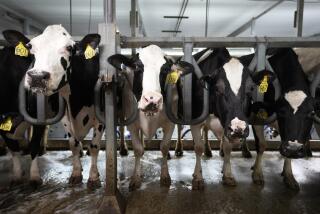Don’t Have a Cow
- Share via
The “mad cow” disease diagnosed in a U.S. cow has set off a new round of predictable, but groundless, panic.
Foreign governments promptly banned imports of U.S. beef. Investors dumped the stocks of beef- related companies. And, of course, what health scare would be complete without hyperventilating calls for even more government oversight of an already highly regulated industry?
There’s no question that bovine spongiform encephalopathy, or BSE -- commonly called mad cow disease -- is a neurological disease in cattle. But the notion that people can contract a human form of mad cow by eating beef from infected cattle is more bun than burger.
The first epidemic of mad cow broke out among cattle in Britain in 1986. Eight years later, human cases of a supposedly novel brain ailment, called new variant Creutzfeldt-Jakob disease, or variant CJD, began appearing in Britain.
Though laboratory testing seemed to indicate that BSE and variant CJD were similar, no one could determine with certainty whether and how the BSE epidemic was related to the “human mad cow” cases.
There were no geographic areas in Britain with a significantly higher incidence of variant CJD cases, and there were no cases of variant CJD among apparently high-risk groups such as farmers, slaughterhouse workers and butchers.
When researchers considered the possibility that variant Creutzfeldt-Jakob disease was caused by consumption of beef from BSE-infected cattle, no correlations could be established between variant CJD and any specific meat or dairy product. No one could even establish whether any of the variant CJD victims ever consumed beef from diseased cattle.
Some researchers nevertheless became fixated on the idea that consumption of infected beef was the culprit behind variant Creutzfeldt-Jakob, especially after it was discovered that 1980s slaughterhouse and meat preparation practices inadvertently might have allowed tissue from diseased cattle to be mixed into packaged meat products such as hot dogs, sausages, beef patties, luncheon meat and the like.
That mere hypothetical possibility spawned mad cow mania.
But the infected-beef hypothesis doesn’t explain why variant CJD tends to occur in young people; most cases have occurred among 15- to 25-year-olds. And it doesn’t offer the slightest clue as to why only about 130 variant CJD cases have occurred in a British population of 60 million people who are exposed to millions of pounds of potentially contaminated beef products.
Some have suggested that a kind of “epidemiological Russian roulette” is at work, where consumption of infected beef results in rare and randomly distributed cases of variant Creutzfeldt-Jakob disease. However, the Russian roulette explanation is not a scientific one and should not be the basis of public alarm or public policy. Despite that, the infected beef theory has mutated into an orthodoxy in the medical and public health community that few have been brave enough to challenge.
One public health expert in Britain, George A. Venters, did manage to publish an article in the British Medical Journal in October 2001 titled “New variant Creutzfeldt-Jakob disease: The epidemic that never was.” Venters maintains that the infected beef theory is simply wrong. He challenges the biological plausibility of BSE causing variant CJD because there is no direct evidence that the supposed vehicle of BSE infection -- a special protein called a prion -- is infectious. Nor is there direct evidence that BSE prions survive cooking, digestion and the human immune system.
After discussing the numerous deficiencies in the BSE-Creutzfeldt-Jakob hypothesis, Venters observed: “The evidence that has been amassed is directed toward confirming the [BSE-CJD] hypothesis rather than testing it. Salient contrary information has either been played down or ignored.”
No doubt much of this rush to judgment was spurred by the 1997 Nobel Prize awarded to the developer of the theory that prions are infectious, Dr. Stanley Prusiner of UC San Francisco. Although his work associates prions with mad cow and Creutzfeldt-Jakob among other diseases, the actual mechanism of infection remains unknown. So prestigious prizes aside, there is as of now no demonstrable causal link between mad cows and human health problems.
BSE-infected cattle should be isolated and destroyed to ensure there is no further spread of mad cow disease among the animals. There is no dispute about this common-sense animal health measure. But variant Creutzfeldt-Jakob is a rare, isolated and apparently random disease of unknown origin. Those conditions don’t justify the current panic about the safety of the beef supply.






